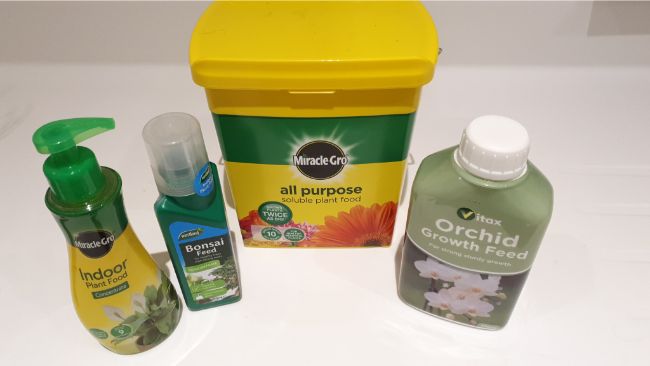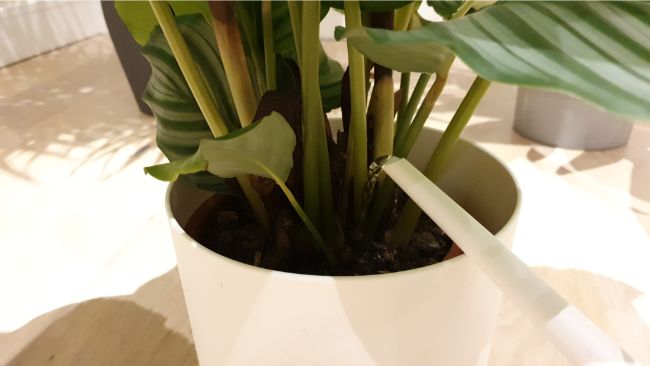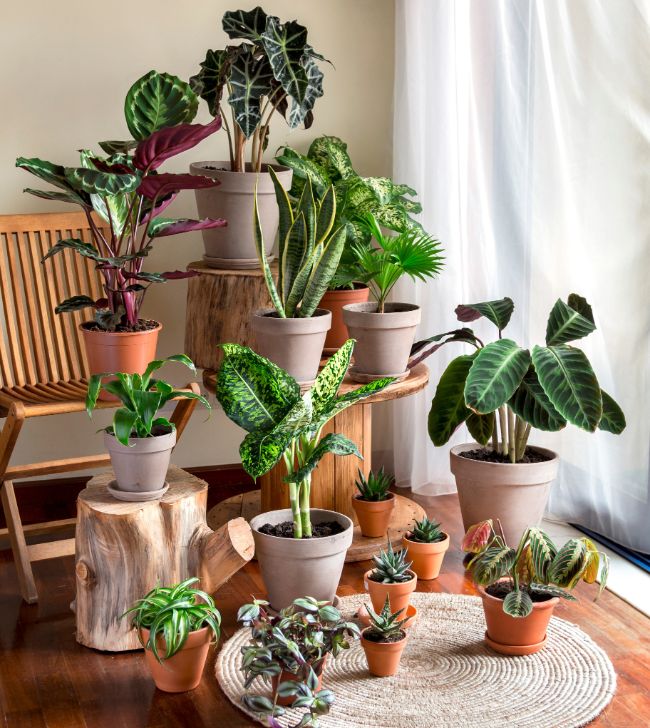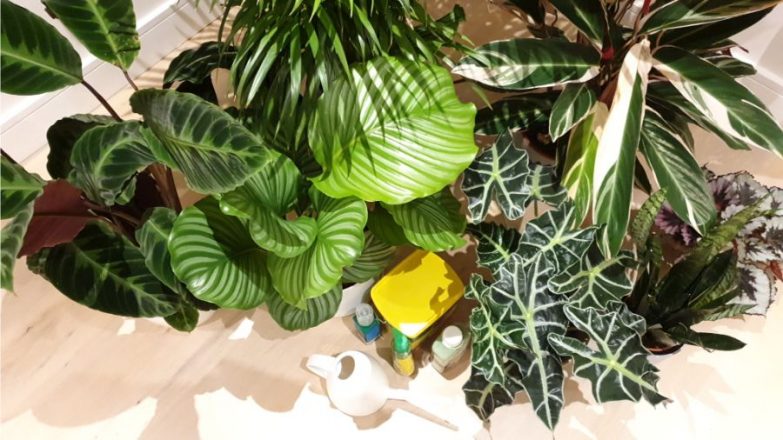Indoor plants need nutrition to flourish, but the best way to fertilize isn’t intuitive. A plant’s needs are very different than our own: it’s easy to make mistakes or feed too often – or too much. In this article, we’ll explain the mysteries of plant nutrition and show you how to fertilize indoor plants so they thrive.
How to fertilize indoor plants: Fertilizer contains nitrogen, phosphorus, and potassium along with micronutrients for a plant’s energy and growth. Most houseplants do well with monthly feedings of a balanced formula at half-strength. Succulents prefer more dilution. Leafy plants appreciate higher nitrogen; flowering plants like extra phosphorus and potassium.
Why Plants Need Fertilizer
Plants consume nutrients from their environment to supply what they need to live and grow. Animals do too; however, because of photosynthesis, that’s where the similarity ends. It’s helpful to think of fertilizer as a multivitamin rather than a meal.
Even though nutrients are necessary to carry out photosynthesis, they aren’t needed in the high quantities that animals require for nourishment. Plants use comparatively simple elements in their conversion of sunlight into complex physical matter.
The end products of photosynthesis are carbohydrates and other compounds that power the plant and provide the raw material for building their roots, stems, leaves, flowers and fruit. In a sense, light is the plant’s main food.
Why You Need To Fertilize Indoor Plants
Nature’s cycle of decay returns nutrients to the soil, but that process isn’t effective in the artificial confines of a plant container. Not only do houseplants exhaust the nutrients in their soil, many potting mixes are infertile to start with. Also, potting soil is leached of nutrition with every watering.
Because the complex chemical reactions of photosynthesis cannot be completed without certain elements, these nutrients must be replenished through fertilization.
Even so, plants don’t need much. They only need to be fed during the growing season. This may be year-round with some tropical plants, but you can quickly over-fertilize a plant that’s going through either a cool-weather or natural cycle of dormancy.

What Do Indoor Plant Fertilizers Contain?
The main elements a plant consumes are nitrogen, phosphorus, and potassium. These play such a fundamental role in plant nutrition that a labeled standard has been developed for consumer information.
NPK Numbers
Fertilizer labels use a specific notation called the NPK ratio. If you look at a retail fertilizer, you’ll find this ratio listed as three numbers separated by a dash. 10-10-10, 2-3-1, and 20-10-10 are examples you might see. The numbers are ordered to correspond to the presence of nitrogen (N), phosphorus (P), and potassium (K).
The size of the number means the percentage by weight of each substance. For instance, an NPK ratio of 2-2-2 contains the same proportion of elements as in a 10-10-10 or 20-20-20 formula … lower numbers indicate a lower percentage of that element relative to the entire mix.
Macronutrients
Each of the three main nutrients are vital for plant growth, but they are used in different ways:
Nitrogen – This is the primary macronutrient for leaf growth. It has a fundamental role in metabolizing energy and synthesizing protein, and effects much of the above-the-soil, visible parts of the plant. Leafy tropicals typically do well with an increased percentage of nitrogen.
Phosphorus – This element is important for producing strong roots, flowers and fruits. Phosphorus assists in the transport and storage of nutrients. Though it is part of a plant’s initial growth, it become more important during the flowering phase.
Potassium – This basic nutrient aids plant metabolism and the transportation of the plant’s reserves. It increases resilience and overall vigor, and takes an active part in flowering and fruit production.
Micronutrients
Plants need smaller amounts of other elements, too. These are called micronutrients because they only constitute up to 1% of the dry weight of most plants and don’t need to be supplied in bulk. In fact, poisoning can occur if the soil contains too much of these elements.
Micronutrients are typically present in organic fertilizers in greater amounts and variety than in manufactured formulas, but there’s a bit of guesswork involved. Micronutrients added to synthetically produced fertilizers can be specified more exactly.
Three of these essential micronutrients are needed by plants in sufficient quantities to also be called secondary macronutrients:
Calcium is used in cell growth and the building of cell walls, along with mineral transport and retention.
Magnesium is vital for photosynthesis because it makes up the core of the chlorophyll molecule. It is essential for activating a variety of plant enzymes.
Sulfur is also an integral part of chlorophyll production and is used in tissue building and protein synthesis. It plays a large part in plant metabolism and supports the efficient use of nitrogen.
Other essential micronutrients include Boron (B), Chlorine (Cl), Copper (Cu), Iron (Fe), Manganese (Mn), Molybdenum (Mo), Nickel (Ni), and Zinc (Zn).
There are also many trace nutrients commonly used by plants that haven’t been proven essential, including Cobalt (Co), Silicon (Si), and Sodium (Na).
Bioavailability
It’s not enough that an element is technically present in the soil: it must also be accessible and available to the plant. Some nutrients may show up in chemical soil tests but aren’t able to be used in photosynthesis or other plant processes.
pH is a controlling factor in whether a plant can utilize a specific element. Bioavailability can also be affected by the type of soil and its organic content, temperature, and other chemical and biological conditions.
Regarding fertilizers, the key bioavailability factor is whether a nutrient exists in a form that functions properly with a plant’s chemistry. For this reason, cheap synthetic fertilizers can have a great-looking label while the elements it lists actually provide little plant nutrition.
This is one area in which organics excel, because their elements usually have high bioavailability.
Types Of Fertilizer
The two basic categories of fertilizer are synthetic and organic. Both can deliver the right nutrients to your plants, but each comes with different costs, benefits, and side effects.
Plants don’t care which type of fertilizer you use; they respond to the ingredients no matter how they show up.
Synthetic Fertilizers
Synthetic fertilizers are created in a laboratory. The process concentrates its nutrients into an easily applied form.
Pros
One great thing about synthetic fertilizers is that you know what you’re getting. The ingredients are listed along with their percentage, so you can dose your plants accurately.
It’s true that the elements of a cheap, inferior brand may be not be in a form most accessible to your plants, but quality synthetic fertilizers generally offer high bioavailability.
Synthetic fertilizers are typically inexpensive. The per-dose cost of decent synthetic fertilizer is already a bargain, so a reputable brand can be quite economical.
These fertilizers are fast-acting, too. They can give your plants an instant boost.
Cons
One drawback to using synthetic fertilizers to fertilize indoor plants is that they’re limited to their labeled elements. Each component is synthesized, so each element must be specifically included. Also, synthetic nutrition usually doesn’t supply microbial and other probiotic additives which can aid fertility.
Another issue is that synthetic fertilizers are so concentrated that they can easily cause burned roots and foliage. You don’t have a wide buffer zone to protect your plant from inaccurate dosing. Even if damage isn’t visible, improper use can overstimulate and weaken the plant.
Organic Fertilizers
Organic fertilizers are made by or from plants and animals. They include worm castings, compost, kelp, blood and bone meal, and fish emulsion.
Fertilizers are certified as organic by the Organic Materials Review Institute (OMRI), so you can check your product for compliance.
Pros
Organics usually provide a greater variety of nutrition than a synthetic fertilizer. Also, because they are produced naturally, most organic nutrients are readily absorbed by plants.
In addition to including many trace elements that contribute to plant health, organics can feed the beneficial bacteria in soil that help plants absorb nutrition. Organically-derived benefits are still being studied. For example, the symbiotic Trichoderma fungus has been found to colonize roots and increases disease resistance and plant growth.
Another important benefit of organic fertilizers is their safety factor. Organic fertilizers offer the three NPK elements at a lesser concentration than synthetics. Because their nutrients are less condensed, there is more leeway in application. It’s hard to accidentally overdose a plant with organic fertilizers.
Cons
One issue with organic fertilizers is you can’t be exactly sure what they include. While they are typically labeled with an NPK ratio, its other fertility factors can be hazy.
Another drawback is that – even though they offer a weak concentration of macronutrients – they tend to be more expensive than synthetics. You can’t always guarantee the faithfulness of an organic source, either; though an OMRI certification provides some assurance.
Some growers defray the cost of organics by setting up their own homegrown systems. Vermicomposting or worm farming is especially popular. Of course this takes time, effort, and the space to do it in.
One final caution about organic fertilizers: they can encourage soil gnats. Be careful to let the topsoil dry out between waterings if you use organics, and consider watering plants from the bottom.
Houseplant Fertilizer Forms
Both synthetic and organic fertilizers come in several forms:
Liquid – Liquid fertilizers let you feed your plants precisely in a measured dose. They are the most convenient way to fertilize indoor plants. Easy to use when watering, they soak evenly throughout the soil. Both organic and synthetic liquid fertilizers are available. The effects are fast-acting.
Dry (Granular, Powdered) – Dry fertilizers are usually synthetic; they are cheap in bulk and easy to store. Granular forms are more commonly used in larger outdoor plantings where they are spread over or plowed into the soil. Overuse of granular fertilizers in potting soil can damage foliage and roots, and they may lead to an uneven distribution of nutrients. A water-soluble powder can be mixed and used as a liquid fertilizer.
Slow-release – Slow-release fertilizers are sticks or pills you add to the soil … they release their nutrients over a period of weeks to months. They may be either synthetic or organic. Though convenient, slow-release products are inexact: you don’t know precisely when the nutrients are released or when they are exhausted. They also tend to result in local concentrations of fertilizer rather than an evenly spread mixture.
How To Apply Fertilizer
How Often To Fertilize Indoor Plants
Many houseplants do well with a 50% diluted application of a balanced fertilizer that includes micronutrients. A monthly application through the growing season is generally recommended. Some growers prefer to fertilize indoor plants more frequently with a more highly diluted solution.
Succulents and other slow-growing plants generally do fine with monthly applications of a quarter-strength solution.
The growing season varies by plant and your area’s climate. You may feed continuously if you live in a tropical region with plants that grow year round; if your area has seasons, curtail feeding when cool weather arrives.
There are exceptions, of course. Some plants do grow throughout the winter indoors – you should generally keep feeding if you continue to see new growth. Use your discretion. Sometimes plants keep their own schedule.
Soil Application

Using liquid fertilizers or a dry mix dissolved into a water-based solution lets you control the dosage and saturate the soil evenly.
Dilute the formula to half- or even quarter-strength. Your plants don’t need as much as most manufacturers suggest, and too little is better than too much.
Water the soil before applying the fertilizer to avoid shocking your plants. If the soil is dry, the plants are primed to uptake moisture and can overserve themselves with a fertilized solution.
Avoid getting concentrated fertilizer on the leaves. Synthetic products are especially prone to leaving spots or burned patches. A watering can with a narrow spout can get close to the soil so you don’t splash the foliage.
Foliar Feeding
Another method to fertilize indoor plants is to spray fertilizer directly on leaves. Foliar feeding is slightly controversial because some growers believe most of the purported benefits come from fertilizer dripping into the soil.
There is evidence, however, that foliar feeding promotes a higher nutrient intake than soil fertilization. The consensus is that it delivers quick, short-term nutrition – it may complement soil-based fertilization but isn’t a complete substitute.
You may want to experiment to see if it works for your plants. Here are some things to know:
- The best time to foliar feed is when the leaf stomata are open: before dawn and after dusk.
- The absorbing stomata are mainly on underneath the leaf, so make sure the fertilizer reaches the undersides.
- A sprayer that delivers a fine mist is better for absorption.
- Fertilize leaves before temperatures exceed about 72° (22°C). The heat closes the stomata of some plants.
- Ensure good airflow around the leaves to avoid fungus and other moisture-related issues.
Fertilizing Needs Of Different Plants
Plant type is a big factor in fertilization. Research your species to find out if it’s a light or heavy feeder.
Once established, leafy houseplants often appreciate a fertilizer with higher nitrogen. On the other hand, cactus and other succulents prefer a lower percentage of nitrogen and do best with a dilution of about ¼ the recommended strength.
Flowering plants consume a larger amount of phosphorus and potassium while in bloom. Plants like African violets that flower continuously do well on their own special formulas year-round.
Annuals and vegetables tend to be heavy feeders that benefit from frequent fertilization—weekly or bi-weekly.
Tips For Fertilizing Indoor Plants
Remember that too little fertilization is better than too much—and to use half the retailer’s recommended dosage.
Here are other tips to fertilize indoor plants safely and effectively:
- There’s a lot of guesswork in using convenient slow-release fertilizers. If you go that route, organics are the safest option.
- Fish emulsion is a fast-acting, nitrogen-rich organic fertilizer that’s great for leafy houseplants – but it stinks! It can be used in a highly dilute solution as part of regular watering. About a quarter-teaspoon or so per gallon is fine. You’ll probably want to do this dilution outside. Yes, it’s that bad.
Pro Tip: Combine with seaweed extract to further reduce the smell; liquid seaweed provides a host of micronutrients and complements fish emulsion’s ingredients.
- It’s better not to use unsterilized home-grown compost for indoor plants because of the chance of disease and pest infestation. It’s easier and safer to use a retail source.
- It’s easy to burn the tender roots of seedlings with synthetic fertilizers. Dilute to at least a quarter of the suggested strength. Organics can be safer but may encourage rot—dilute these products by at least half. Feed once a week after their first true leaves appear. The rule to feeding seedlings is: weekly, weakly.
- The time to start fertilizing a new plant depends upon its type and condition as well as the season. If you’re wondering when to feed a new gift or purchase, look for small colored balls in the soil that indicate slow-release pellets. If you see them, it’s best to wait from four to six months to let the nutrients leach out.
- Fertilizing doesn’t help a sick plant and can make their problem worse. Plants have limited needs for nutrients, and you can’t force feed them.
Avoid These Mistakes When You Fertilize Indoor Plants

Overfertilization
It’s easy to overdo it when you fertilize indoor plants. It’s a common mistake for beginners. We love our plants and want to stuff them with goodies – but it doesn’t work that way. Plants can only take in so much nutrition at once.
Remember that plants make their own food. Light is their main nutritional ingredient, so it’s easy to overestimate the fertilizer they need.
It’s possible to overdose using an organic fertilizer, but it’s less likely than when using synthetic products. Synthetics are not only concentrated, they don’t supplement the living network of symbiotic organisms that foster plant nutrition. They can more easily cause toxic imbalances and heavy chemical residues.
Here are common ways you can overdose your plants:
- Excessive use of slow-release fertilizers.
- Applying a combination of different forms of fertilizer.
- Poor soil drainage that leaves residue fertilizer in the soil.
- Dry soil at the time of fertilization.
- Continuing to fertilize during dormancy.
As a final note, the overuse of fertilizers can cause environmental problems, too. The excess nutrients can run off into local groundwater.
Symptoms
The immediate symptoms of overfertilization are shock which causes yellowing and/or wilting of the lower leaves. Brown leaf tips and edges are other signs.
Note: Overwatering can also cause yellow leaves, so rule it out before treating. Flushing soggy soil with more water could finish the poor plant off.
Longer-term salt buildup from fertilizer residue also builds up problems. It slows the flow of water into the roots and can weaken the plant. Sometimes a crust of excess fertilizer shows on the surface of the soil. Fertilizer residue on terra cotta pots shows up as stains on the outside.
Other symptoms from accumulated overfertilization appear over time. Too much nitrogen can cause leggy growth that attracts juice-sucking pests. Other symptoms are a loss of leaves, slow growth or stagnation, or increased incidence of root rot.
Solutions
Moderation is the first defense. In addition to diluting your fertilizer, avoid feeding plants that already have slow-release products in their soil. Consider using fertilizers with low NPK values.
Correct watering is also important: each time you water, make sure the flow saturates the entire soil mix and exits freely from the drainage holes. This helps to leach excess fertilizer from the soil so residue salts don’t build up too quickly.
Flushing the soil is a good maintenance practice. You should do this approximately every six months—or as often as once a month if you’re fertilizing heavily. Also flush the soil if you see yellow leaves or other signs of overdose.
The flushing process is simple:
- Pour water over the top of the soil so that it flows from the bottom drainage holes. Repeat this several times; let the soil drain completely in between.
- For delicate plants, it’s best to use conditioned or filtered water.
- Repeat the process in a few hours or on the following day.
If your plant has been overfertilized through slow-release products or a combination that includes them, consider repotting with fresh soil to give them a clean start. It’s difficult to flush out the excess salts of an active slow-release fertilizer.
Underfertilization
Underfertilization is less common than overdosing, and the symptoms can be similar to overwatering, overfeeding, or other maintenance issues. Unfortunately, the symptoms can also be vague, such as a general loss of vigor or slow growth.
Don’t assume nutritional deficiencies are the reason for your plant’s poor performance – rule out other possible issues first. Underfertilization is actually one of the least common reasons for houseplant problems. Review your overall care regime before making a diagnoses.
Symptoms
A plant struggling with lack of nutrition often displays pale leaves and weak stems. The lower, older leaves often appear drained or yellow as energy is redirected to new growth. The plant may be stunted or exhibit slow progress overall.
Other symptoms are reduced color or failing to flower well. Underfertilized plants also have less resistance to pathogens.
Here are symptoms that indicate specific deficiencies:
- Pale, light-green new growth and yellowing older leaves can be a sign that a plant needs nitrogen and is sacrificing mature growth for production. Nitrogen deficiency can also cause malaise and slow growth. There may be leaf loss that begins from the bottom of the plant.
- Plants short of potassium can exhibit chlorosis, or light green foliage, along with dark green veins. Dark spots may appear on the foliage, or the leaves may turn inward and become weaker and easier to break off.
- If older foliage turns purple while younger growth remains dark green, this could signal a phosphorous deficiency. A shortage of phosphorous can also cause late or poor flowering, the browning or wrinkling of the leaves, or a general lack of vigor.
Deficiencies in secondary macronutrients aren’t common, but they can still have a visible effect:
- Insufficient calcium can cause yellow and brown spots on the leaves. It also slows plant growth in general.
- Magnesium deficiencies result in weak stalks, loss of green color in the oldest leaves, and the appearance of yellow and brown spots even though the veins remain green.
- A shortage of sulfur is rare, but when it does occur the plant becomes lighter and takes on a pale green appearance. It may develop general chlorosis similar to that of a nitrogen deficiency.
Solution
If you suspect a particular deficiency, you can apply a fertilizer higher in the element you wish to boost – but it’s best to use a formula that includes the other nutrients, too. You want to encourage balanced fertility and not to overload the soil with a single element.
If your plant is beginning to flower and seems to be struggling, it may benefit from an extra helping of phosphorus and potassium. An effective retail “bloom booster” usually does the job, but make sure it includes the secondary macronutrients: calcium, magnesium, and sulfur.
If you’ve ruled out other possible reasons, soil testing can give answers about missing nutrients. Remember that overfertilization causes more trouble than it solves, so don’t go overboard. Dilute your fertilizer, but otherwise closely follow the instructions.





